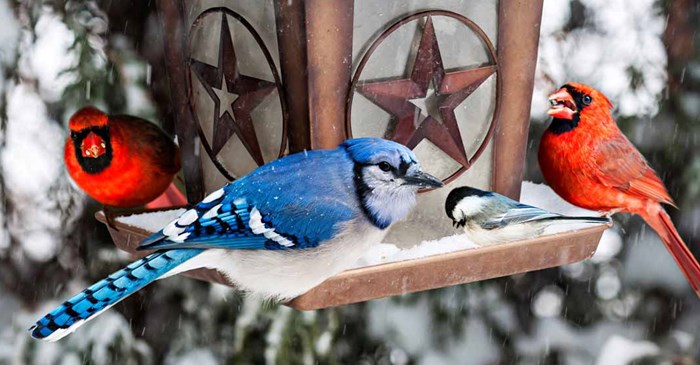Though the insects of summer have disappeared with the arrival of winter weather, plenty of birds don’t migrate and live year-round in cold weather areas. Here are five species to watch for at the feeder and in your backyard:
Northern Cardinal
With their beautiful red feathers and signature crest atop their heads, it’s no wonder these are feeder favorites. Often, these are the very first and the final feeder visitors of the day. When daylight is barely there, sit back and watch quietly. A cardinal or two just might show up.
Cardinals are easy to spot due to their bright red plumage against the white, whimsical background of winter. They don’t molt, don’t migrate from their home, and are found throughout the eastern half of the U.S. So if you have cardinals visiting throughout warm months of the year and continue to fill your feeder with Lyric Cardinal Mix through winter, you will continue to see them.
Black-capped Chickadee
These bold, social birds are adored by many for their cute, round shapes, easily recognized calls, and bold personalities. By winter, they’ll show up in small, noisy flocks, often accompanied by woodpeckers, kinglets, and nuthatches. Chickadees take turns at the feeder, each picking up a single seed in their small, pointed beaks, and flying away to dine under the protective cover of a nearby tree or bush.
Adult chickadees don’t migrate, so if you see them in spring and summer, you will see them in winter as well. If you live in the northern half of the U.S., keep an eye out for Black-capped Chickadees as they will more than likely be searching for a snack.
If you want to up your chances at seeing chickadees at your feeders, try Lyric Chickadee Mix! Specially formulated for small-beaked birds, it includes black oil sunflower seed, sunflower kernels, peanuts, pecans, and pistachios - all favorites of not only chickadees, but nuthatches and titmice too!
Blue Jay
Blue Jays are social and intelligent birds, and their lively antics make feeder watching fun. For instance, a single jay may come in for a landing and imitate the calls of a hawk or a crow before diving in for his dinner. It’s all part of his cunning plot to fake out his buddies and other songbirds so he can have the bounty to himself!
Much like cardinals, the bright blue plumage of the Blue Jay is easily recognizable against a winter landscape. They don’t migrate from their homes - so if you live in the eastern half of the U.S., you will continue to see Blue Jay’s at your feeders this winter.
Blue Jays love peanuts, nuts, and sunflowers. Try Lyric Delite No Waste Mix and watch the jays gather!
Downy Woodpecker
Winter is the season for getting some great up-close views of woodpeckers at the feeder. Found throughout most of the U.S., Downy Woodpeckers are familiar, frequent feeder visitors. During the winter, you can find them hanging out in groups of mixed birds. Being part of these larger groups allows birds to find more food sources in the winter and make the most of the food being offered to them.
If you’re looking to draw woodpeckers and other birds to your feeders this winter, try Lyric Woodpecker Mix! This mix of nuts, fruits, and sunflower seeds is an excellent source of protein and fat for wild birds - perfect for keeping them well-fed and energized during cold, winter months.
Dark-eyed Junco
This summer resident of the Arctic Circle lends new meaning to flying south for the winter, and those who love these slate-colored sparrows welcome their arrival with the cold weather.
What are your top five winter birds? Keep your feeders filled with Lyric Supreme Wild Bird Mix and keep an eye out for birds who will be sure to visit all winter long.
